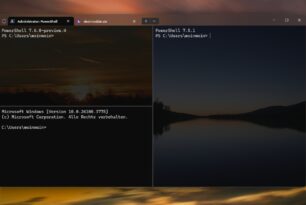Wer mit dem Firefox 65 unterwegs ist und Avast oder AVG als Antiviren-Programm installiert hat, wird derzeit Probleme mit den Zertifikaten haben. Denn jede Webseite die man ansteuert wird mit „Ihre Verbindung ist nicht sicher“ angegeben. Daraufhin hat Mozilla das automatische Update des Browsers erst einmal deaktiviert.
Jedenfalls solange, bis das Problem behoben wurde. Siehe Bugzilla. Heute soll von Avast und auch AVG, ist ja eine Firma, ein Patch per Update verteilt werden, sodass die HTTPS-Filterung für den Firefox erst einmal deaktiviert wird. Danach geht es dann an die Ursachenforschung und das eigentliche Problem wird dann später behoben.
Im Firefox selber kann man solange in about:config security.enterprise_roots.enabled solange auf true setzen. Es können aber auch andere Antiviren-Programme betroffen sein. Darüber gibt es aber derzeit keine genauen Infos. Wer trotzdem den Firefox 65 installieren bzw. aktualisieren will, kann dies natürlich auch manuell machen.








passend zum Thema Firefox 65:
der kann jetzt bekanntlich auch als *.msi Datei installiert werden.
Habe die letzten Tage mal damit rumgespielt. Hier meine Erfahrungen/Erkenntnisse:
man braucht nicht erst FF herunterladen um dann zu installieren. Geht jetzt auch unbeaufsichtigt per Kommande in einem Schwung:
msiexec /passive /norestart /i „https://download.mozilla.org/?product=firefox-msi-latest-ssl&os=win&lang=de“ START_MENU_SHORTCUT=true DESKTOP_SHORTCUT=true INSTALL_MAINTENANCE_SERVICE=false REMOVE_DISTRIBUTION_DIR=false TASKBAR_SHORTCUT=true /quiet /norestart
alles nach „win&lang=de“ ist optional. Ich habe da jetzt mal so ziemlich alles reingepackt was geht.
Der Befehl würde einen aktuellen FF X86 (derzeit Version 65.0) herunterladen und installieren. Für einen FF 64 bit müßte „win64&lang“ eingetragen werden.
Für einen englischen FF statt „=de“ „en-US“ eingeben.
ohne Download:
msiexec.exe /i „c:MSidefault.msi“ INSTALL_DIRECTORY_PATH=“C:Firefox“ TASKBAR_SHORTCUT=false DESKTOP_SHORTCUT=false INSTALL_MAINTENANCE_SERVICE=false /quiet
msiexec.exe /i „c:MSidefault.msi“ INSTALL_DIRECTORY_PATH=“C:Firefox“ TASKBAR_SHORTCUT=false DESKTOP_SHORTCUT=false INSTALL_MAINTENANCE_SERVICE=false /quiet
ein ´hab ich noch:
Creating a Firefox MST or Transform file
An MST file is like a patch for a MSI installer that you can then apply when performing an install. This allows you to change, or transform, the install process by passing the MST file as an argument to the MSI installer.
To create an MST file, you need to download the Windows SDK Components for Windows Installer Developers and install the Orca.exe program. Once Orca is installed, run it and click on File and then Open and then select the MSI file that you wish to create a MST file
Once the MSI file is opened, click on the Transform menu and select New Transform as shown below.
When a new Transform has been started, the Orca window title will now include „transformed by untitled“ to indicate that you are in the transform mode.
Now click on the Property table as shown below. This will list all of the custom Firefox properties that you can configure for your MST file. For descriptions on what each property does, you can review this document.
To change a property, simply double-click on it and enter the new value. For boolean properties, the data can either be true or false. As you can see in the image below, we have changed the INSTALL_DIRECTORY_PATH property so that Firefox will be installed in the C:\Firefox65-Nightly\ folder.
When you are done configuring the properties, click on the Transform menu and select Generate Transform.
Orca will now generate a MST file and ask you where to save it. In our example, we will be saving the mst file as „custom.mst“. After you save the MST file, you can close the Orca program.
To use this newly generated MST file when installing Firefox, you would need to open a command prompt and enter a command like the following.
msiexec /i firefox-65.0.en-US.win64.installer.msi /lvx msi.log TRANSFORMS=“custom.mst“
When using this command, the Firefox MSI installer will execute and be transformed by the custom configuration saved in the custom.mst file. The „/lvx msi.log“ part of the command will generate a log file called msi.log in the same folder that you executed the command.
This log file can be used to debug problems that you may encounter when installing the MSI.
INSTALL_DIRECTORY_PATH=[path] to define a path for the Firefox installation.
INSTALL_DIRECTORY_NAME=[name] to define the name of the Firefox directory.
TASKBAR_SHORTCUT={true,false} defines whether a taskbar shortcut is placed during installation.
DESKTOP_SHORTCUT={true,false} defines whether a desktop shortcut is placed during installation.
START_MENU_SHORTCUT={true,false} defines whether a Start Menu shortcut is placed during installation.
INSTALL_MAINTENANCE_SERVICE={true,false} defines whether the Maintenance Service is installed.
REMOVE_DISTRIBUTION_DIR={true,false} defines whether the distribution directory of an installation is removed.
PREVENT_REBOOT_REQUIRED={true,false} to allow or prevent reboots if required.
OPTIONAL_EXTENSIONS={true,false} ti allow or disallow the installation of bundled extensions.
EXTRACT_DIR=[directory] extracts the Firefox files without installing them.
MSIEXEC options are supported as well.
/i or /package will install the browser.
/L or /log writes to a log file.
/m generates an SMS status .mif file.
/q, /quiet, or /passive to install Firefox silently
/norestart, /forcerestart, or /promptrestart to block, force or prompt users for a restart.
Es gibt gute Gründe das Filtern der SSL-Verbindung überhaupt zu lassen. Wenn das Antiviren-/“Sicherheits“-Programm auf Man-in-the-Middle macht, ist das keine wirklich sichere Verbindung mehr. Es gibt genügend Produkte, die über die Jahre immer wieder Ärger/Sicherheitslücken beim Filtern von SSL mit Zertifikaten hatten. Da wurden sichere Chiffren runter gestuft oder gar gefälschte Zertifikate als sicher angenommen.
Fehler Behebung:
In Firefox auf Hilfe klicken, dann auf Informationen zur Fehlerbehbung, und dann rechts oben Firefox Bereinigen, dann geht alles wieder.
Fehler tritt nicht nur Avast und AVG auf sondern auch Mac OSx und Linux auch Kaspersky und Norton.
Was weiß die dritte Person von Herrn Hugo dazu? Folgende Fakten:
dazu? Folgende Fakten:
– Haupt-PC mit Win7
– Administrator-Konto
– avast! schon laaange installiert
– auf FF 65 upgedatet vor dem Stop (per auf Hilfe im Browser)
Bis jetzt konnte ich jede Website ohne Probleme ansteuern, mir ist kein Problem aufgefallen – Stand 00:00 am 2.2.19
Ich glaube ja dass der Fehler nicht bei Mozilla / FF zu suchen ist sondern bei dem Antiviren Scheißgedöns was die Leute als Addon im Browser zulassen um „NOCH MEHR SICHERHEIT“ zu haben.